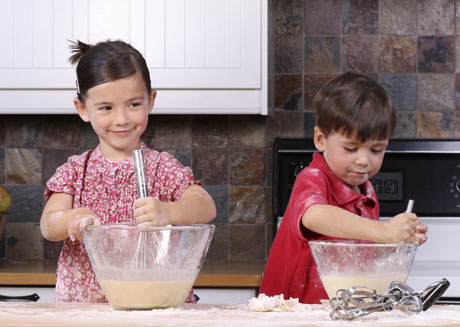 Want to keep your child science-smart in the summer? Perhaps you feel your daughter isn’t engaged enough in science during the school year, and you think the summer months might be the perfect time to sharpen her interest and skills. Or maybe your son simply doesn’t have time to focus on hands-on science projects between his usual routine of school, activities and homework.
Want to keep your child science-smart in the summer? Perhaps you feel your daughter isn’t engaged enough in science during the school year, and you think the summer months might be the perfect time to sharpen her interest and skills. Or maybe your son simply doesn’t have time to focus on hands-on science projects between his usual routine of school, activities and homework.
Here are some ideas to get you and your kids started on some smart, stimulating summer science. Choose the ones that fit best with your child’s interest and personality.
If your child is …
1. An artist
Why not bring the watercolors outside? Observing the world is the first step in any artistic or scientific process. Everyone knows you don’t plan an experiment without a hypothesis. Well, you can’t have a hypothesis without an observation.
Looking at the world as an artist teaches kids to see details they might not otherwise notice. So set them up with paper and crayons or acrylics and an easel and let them paint a tree, a grasshopper, the family pet. Ask them to point out various features (wings = fly, fur = warm) or have them paint two different species of flowers or birds and compare them.
A flower press also offers a way to overlap science and art. With just a few heavy books, you can turn an ephemeral bloom into a permanent work of art. Pick flowers as they begin to dry but before they wilt. Press them slightly in your hands and then place between tissue or paper between the pages of a heavy book. Add more books for weight, or position the flowers between two pieces of wax paper and iron them, sealing the bloom in the paper.
Tie ribbons to the flowers and hang in front of a window or decorate a whole room. Ask your children to compare the different flowers they are pressing, or pick extras and dissect some of them into their parts. Can your kids find the pollen?
2. A reader
Some kids will love a straight-up nonfiction book about snakes or airplanes. Others might want their science integrated into a story or pictures. Swirl by Swirl: Spirals in Nature by Joyce Sidman is a gorgeous look at shapes in the natural world that’s great for kids ages 4–8.
Another book for similar ages, Forest Has a Song by Amy Ludwig VanDerwater [she wrote all of the poems] is a compilation of punchy poetry about a forest.
Middle school kids will enjoy Carl Hiassen’s books Hoot and Flush, both romping mystery adventures about conservation. Kids might also like Autumn Winifred Oliver Does Things Different by Kristin O’Donnell Tubb, a fun-loving historical fiction book narrated by a spunky girl whose home is being taken away for the creation of a national park.
Have older kids? They’ll enjoy Nancy Farmer’s The House of the Scorpion, a dystopian adventure about a clone. And The Immortal Life of Henrietta Lacks by Rebecca Skloot is a well-told true story about the woman whose cancerous cells became the first stem cells, a great read for any high schoolers interested in biology, especially those who are already thinking about heading into the medical profession.
3. A builder
Constructing the death star out of Legos might be the beginning of an obsession, but it doesn’t have to be the end. Look for Lego robotics clubs, where kids can take their passion to the next level and bring out their inner engineer. You can also find build-your-own robot kits. We love the Tamiya series — there is often a Tamiya mechanical ostrich and mechanical beetle scurrying around my kitchen floor.
4. A chef
Introduce your young gourmand to some of the scientific miracles of cooking. Make cookies with baking soda and then use the same ingredient to construct a volcano. You can learn about microbes and then make homemade batches of bread, yogurt and cheese. DIY kits are often available in supermarkets; if not, you can find them easily online.
Cooking is just chemistry applied to food. So if your son likes to mix it up in the kitchen, why not encourage him to mix it up in a test tube as well? Find great ideas for easy kitchen science experiments online (search for sugar or salt crystals, homemade volcanoes, invisible ink, or try this website). You can also purchase a science experiment kit at any museum store and at most toy stores.
5. A wizard
Have a Gryffindor at home? If your daughter is into magic, check out Scientific Explorer Magic Science for Wizards Only kit. This ready-to-go set of science experiments will have you making glow-in-the-dark bubbles and color-changing solutions in no time. And it comes complete with a make-your-own wizard hat and wand. This is one of the best experiment kits we’ve tried (and we’ve tried a lot)!
6. An animal lover
Show your kids that there are more animals out there than they can see with one glance.
A jar of pond water and a microscope can open up a whole world that children never knew existed as they watch the tiny microscopic critters glide, wriggle and swim across the slide. You can find identification pages online so your kids can learn more about what they are examining. One of these sites is microscopy-uk.org.uk; click the “Pond Life ID Kit” link in the column on the left.
7. A collector
Does your little one like to categorize, count and collect? That’s a first-rate scientist skill! It’s also important for mathematical development. He might currently be using his talents on stickers or trading cards, but why not shells, rocks or pressed leaves?
The next time you take a hike, the kids will have an added incentive to keep their eyes open if they are looking for the next item in their collection.
8. A photographer
A collection doesn’t have to be something you take home. Kids can collect photographs with a kid-friendly camera. (We like the Vtech Kidizoom—the camera is sturdy, and it’s easy to download the pictures to a computer.) Have a family scavenger hunt at the local park and see who can take pictures of the most fascinating bugs, trees, dogs or anything else you — or your kids — are interested in.
It would be hard to get through a summer without any science in your life. The trick is to realize connections between what your kids already enjoy and the natural and physical sciences.
Wendy Lawrence surprised no one more than herself by majoring in biology and going on to teach middle school science. Now she builds robots, volcanoes and backyard gardens with her two young sons and husband in Ann Arbor, Mich.
Super Science-Centric Field Trips
Woodland Park Zoo
A new bamboo forest exhibit opened on May 4 and includes a kids’ nature play area.
Mount Rainier National Park
Take advantage of the Junior Ranger program, the great hiking and the fun family campgrounds.
Northwest Trek Wild Animal Park
See bison, elk and bighorn sheep from the tram tour or challenge yourself on the new zip-line obstacle course.
Museum of Flight
Airplanes, spacecraft, a great kids’ play area — and the café’s offerings are a huge step up from the usual grilled-cheese museum eatery fare.
Burke Museum of Natural History and Culture
An eclectic and interesting museum, the Burke has a lot to offer, and a family events page on its website tells you what is coming up for kids.
IslandWood
This Bainbridge Island sustainability center not only offers great summer camps, but activities for the whole family.
Seattle Aquarium
Get the kids excited first by watching the otter cam online before you go.
Pacific Science Center
Time your visit so you get to see a live science show, planetarium presentation or IMAX movie.
Olympic National Park
This park offers snow-capped mountains, temperate rain forests, rocky coastline and sandy beaches. You can camp or stay at the many hotels in the areas. And if your teen is reluctant to get dripping wet in a rain forest, just remind her that Twilight was filmed here and begin at the town of Forks, forkswa.com.
Point Defiance Zoo & Aquarium
Located in Tacoma, this cool zoo offers daily programs, such as a talk given by an elephant keeper, a shark feed, a presentation by a polar bear keeper and more.











